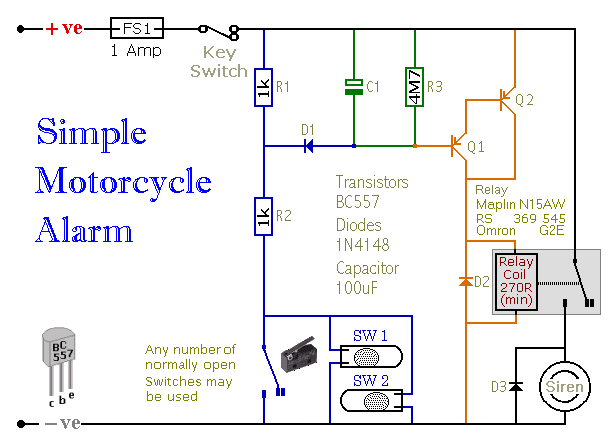
clk3 binary alarm clock

This is the first electronic circuit designed from scratch, marking the initial experience with programming a microcontroller (MCU), the first application written in assembly language, and the second homemade printed circuit board (PCB). While it is common for individuals to start with simple projects and gradually increase complexity, this approach involves tackling more advanced designs to accelerate learning and development. The circuit converts an input voltage of 7-35V to 5V using an LM7805 voltage regulator. The MCU can be programmed via in-circuit serial programming (ICSP) by connecting the programming cable to P2 and activating positions 6 and 7 of switch S5 while deactivating the others. For operation in clock mode (as opposed to programming mode), positions 1-5 of S5 must be activated, while positions 6 and 7 are deactivated. LEDs indicating hours are connected to PORTA, those for minutes to PORTC, and seconds to PORTD. Button S1 increments the time by one hour, S2 by one minute, S3 sets the current time, and S4 sets the alarm time. Diode D21 appears to be oriented incorrectly, but this is not the case; P1 serves as the power jack, requiring current to flow from the circuit's ground to P1-1, which is the ground for the external power supply. The circuit features two ground lines: GND and Vss. Typically, these are connected, but they are separated during programming to ensure that Vss (the ground for the ICSP programmer) is isolated from the rest of the circuit.
The electronic circuit described functions as a basic digital clock with alarm capabilities. The LM7805 voltage regulator is a crucial component, converting a higher input voltage (ranging from 7V to 35V) to a stable 5V output, which is essential for powering the MCU and other components. The design utilizes a microcontroller programmed in assembly language, allowing for efficient control of the clock's operations.
The ICSP feature enables easy reprogramming of the MCU, facilitating updates or modifications to the clock's firmware. The switch S5 serves as a mode selector, allowing the user to toggle between programming and clock operation modes. The inclusion of multiple buttons (S1 to S4) provides intuitive user interaction for setting time and alarms, enhancing the overall usability of the device.
The use of PORTA, PORTC, and PORTD for driving the LEDs indicates a well-structured approach to managing the output display. Each port is utilized for specific time intervals (hours, minutes, and seconds), ensuring that the circuit can visually represent the current time effectively.
The design consideration regarding the diode D21 is noteworthy, as it highlights the importance of understanding current flow in the circuit. The separation of GND and Vss during programming ensures that the programming process does not interfere with the normal operation of the clock, maintaining the integrity of both functions.
Overall, this circuit exemplifies a blend of foundational electronic principles with practical application, showcasing the capabilities of microcontrollers in building functional and interactive devices.This is the first electronic circuit I designed from scratch, my first time programming a MCU, the first time I wrote an application in assembly language and my second homemade PCB. Usually people starts building very simple things and they increase the complexity of their work a bit at a time, but I prefer to learn and build things much more comp
lex than I am (theoreticaly) capable of, so I learn and work much more faster. Input 7-35V is converted to 5V using a LM7805. The MCU can be programmed by ICSP plugging the programming cable to P2 and activating positions 6 and 7 of S5 and deactivating the rest of them. For using the circuit in clock-mode (not programming-mode) positions 1-5 of S5 must be activated and 6-7 deactivated.
LEDs used to show the hours are connected to PORTA, those used to show minutes to PORTC and for seconds to PORTD. Button S1 rises the time one hour, S2 one minute, S3 sets up the actual time and S4 the alarm time. The diode D21 seems to be upside down but it isn`t because P1 is the power jack, so current must flow from the GND of the circuit to P1-1 which is the ground of the external power.
The circuit has two ground lines: GND and Vss. Usually (clock-mode) they are shorted but they are split when the PIC is being programmed so Vss (ground of the ICSP programmer) is completely isolated from the rest of the circuit. 🔗 External reference
The electronic circuit described functions as a basic digital clock with alarm capabilities. The LM7805 voltage regulator is a crucial component, converting a higher input voltage (ranging from 7V to 35V) to a stable 5V output, which is essential for powering the MCU and other components. The design utilizes a microcontroller programmed in assembly language, allowing for efficient control of the clock's operations.
The ICSP feature enables easy reprogramming of the MCU, facilitating updates or modifications to the clock's firmware. The switch S5 serves as a mode selector, allowing the user to toggle between programming and clock operation modes. The inclusion of multiple buttons (S1 to S4) provides intuitive user interaction for setting time and alarms, enhancing the overall usability of the device.
The use of PORTA, PORTC, and PORTD for driving the LEDs indicates a well-structured approach to managing the output display. Each port is utilized for specific time intervals (hours, minutes, and seconds), ensuring that the circuit can visually represent the current time effectively.
The design consideration regarding the diode D21 is noteworthy, as it highlights the importance of understanding current flow in the circuit. The separation of GND and Vss during programming ensures that the programming process does not interfere with the normal operation of the clock, maintaining the integrity of both functions.
Overall, this circuit exemplifies a blend of foundational electronic principles with practical application, showcasing the capabilities of microcontrollers in building functional and interactive devices.This is the first electronic circuit I designed from scratch, my first time programming a MCU, the first time I wrote an application in assembly language and my second homemade PCB. Usually people starts building very simple things and they increase the complexity of their work a bit at a time, but I prefer to learn and build things much more comp
lex than I am (theoreticaly) capable of, so I learn and work much more faster. Input 7-35V is converted to 5V using a LM7805. The MCU can be programmed by ICSP plugging the programming cable to P2 and activating positions 6 and 7 of S5 and deactivating the rest of them. For using the circuit in clock-mode (not programming-mode) positions 1-5 of S5 must be activated and 6-7 deactivated.
LEDs used to show the hours are connected to PORTA, those used to show minutes to PORTC and for seconds to PORTD. Button S1 rises the time one hour, S2 one minute, S3 sets up the actual time and S4 the alarm time. The diode D21 seems to be upside down but it isn`t because P1 is the power jack, so current must flow from the GND of the circuit to P1-1 which is the ground of the external power.
The circuit has two ground lines: GND and Vss. Usually (clock-mode) they are shorted but they are split when the PIC is being programmed so Vss (ground of the ICSP programmer) is completely isolated from the rest of the circuit. 🔗 External reference





